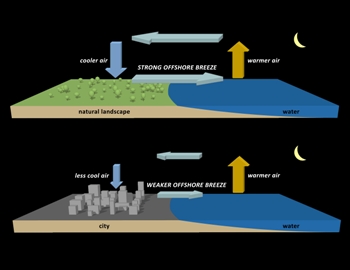A recent study undertaken by the National Center for Atmospheric Research (NCAR), in the Houston area hints that large level of urban developments ultimately changes wind flow patterns leading to pollutant buildups within the city in the warm summer months.
 Paved surfaces in the Houston area keep the city warmer than more natural surfaces
Paved surfaces in the Houston area keep the city warmer than more natural surfaces
It clarifies that the increased number of paved areas subdivisions, strip malls prevents the natural flow of wind that is required to remove pollutions.
The team of study mixed wide-spread atmospheric measurements along with computer simulation to study the impact, the pavements can make on the flow of breeze in Houston. They detected that the pavements dowsed in heat all through the day keeps the land areas comparatively warmer in the night, thus reducing the difference in the land and sea temperatures during the summer period, which in turn causes reduced level of wind blow during night time. Also the higher level building structures within the land obstructs free movement of wind, which leads to inactive weather conditions in the noon. Though the paved urban areas with increased temperature tend to draw wind from the sea during day time this is counterbalanced due to the changed wind patterns that allow the movement of air towards the sea.
The study cautions that the expansion of Houston city will further weaken the flow of winds during summer creating more pollution related problems. It further suggests that the developmental patterns in the city should combine with the extensive park systems of the city to improve the quality of air within the city for the benefit of all.
The study explains that the drought conditions will further increase the air pollution because the dry soil gets heated up quickly than a wet soil during a sunny day. The excessive heat released by the land during night time narrows the temperature difference between the land and sea water leading to reduced level of nighttime wind from offshore.